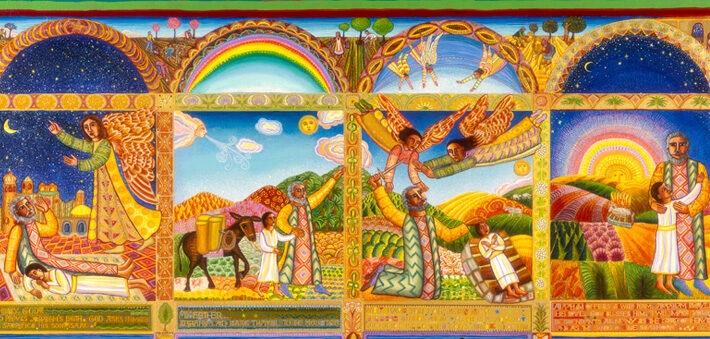Commentary on Jeremiah 28:5-9
The test of truth and validity of a prophet’s words is whether or not the prophet’s words come to pass.
If the prophet’s words come to pass the seer is a true prophet. A prophet’s credibility increases dramatically if the prophet’s words come true. If the words do not come to pass, the speaker is a false prophet. It would seem to be a simple test.1
Simple, perhaps, but also costly, likely ending in the death of the false prophet(s). For Elijah, the test was on Mt. Carmel where he defeated 450 prophets of Baal (1 Kings 18:20-40). For Jeremiah, that test comes in the form of a conflict with just one man, Hananiah (Jeremiah 27-28).
Understanding the conflict between Jeremiah and Hananiah requires taking a look at several key features of the story: (1) the difference between temple theology and covenant theology, (2) the image of the yoke, and (3) the tragedy of Zedekiah.
First, the clash between Jeremiah and Hananiah can be seen as an ideological/theological conflict between temple theology (a theology in which bad things could not, would not happen to Israel or its temple because of God’s promise of protection) and covenant theology (a theology of rewards for obedience and punishment for disobedience; similar to retribution theology). Temple theology is the communal side of retribution theology in which prosperity and a pleasant life are to be expected if one is obedient to God. Both are attempts at defining a predictable life. For centuries, since the time of David as recorded in 2 Samuel 7, temple theology promised God’s unswerving care to protect Jerusalem from each and every foe. Temple theology gave the false impression that Jerusalem was invincible.
Second, regarding the imagery of the yoke, in 27:2 God commands Jeremiah to make and wear a yoke around his neck to represent the notion that Babylon would be a heavy yoke on the necks of many nations including Edom, Moab, Ammon, Tyre, and Sidon. Babylon also would be a yoke around Judah’s neck if Judah rebelled against Babylon.
Third, mention of Zedekiah in verse 1 is a reminder that Hananiah’s story takes place during the days of Judah’s decline. Although Zedekiah is not a character in the story, Zedekiah’s story is the backdrop that compounds the tragedy of Hananiah. Zedekiah was Judah’s last king. Placed on the throne by the Babylonian king, Nebuchadnezzar II, he reigned eleven years. Although Jeremiah advised against fighting the powerful Babylonian empire, Zedekiah rebelled and lost. Not only was the temple destroyed, his sons were killed before his eyes. His eyes were put out. He was taken captive to Babylon where he died in prison.
Having heard nearly forty years of Jeremiah’s prophetic words of warning, Hananiah must have longed to hear some good news for a change. Hoping to encourage himself and others as well, Hananiah spoke words of peace that he and undoubtedly the nation longed to hear. In the presence of Jeremiah, priests, and the people of the community Hananiah made a public pronouncement diametrically opposed to the warnings that Jeremiah had been preaching for years. Rather than repeat Jeremiah’s dismal picture of crushing defeat and lengthy three-generation exile, Hananiah painted an idyllic picture that was likely to please his audience. Looking through rose-colored glasses he declared that not only would Babylon be defeated, but any exile would be short-lived, two years not seventy. Moreover, Judah’s treasures would be returned to the temple, Jehoiakin (the king who preceded Zedekiah) and other captives would return to the homeland. With one or two of the three waves of Babylon’s takeover complete, these words of a soon-to-be restoration would be good news to his listeners’ ears.
Jeremiah, however, would have nothing of it. He retorted that he hoped Hananiah’s vision would come to pass. However, standing in and on the prophetic office to which God called him, Jeremiah reminded his audience that through the ages, prophets spoke of hard times, difficult times, times of “war, famine, and pestilence against many countries and great kingdoms” (Jeremiah 28:8b). Prophets’ words, unwelcome as they are, are words of truth and reality that people (then and now) would rather not hear.
Of the confrontation between Jeremiah and Hananiah Mignon Jacobs writes:
Chapters 27-28 report Jeremiah’s … confrontation with Hananiah the prophet. … What is at stake in this confrontation is the validity of two competing ideologies regarding God’s people and God’s involvement on the world stage. On the one side are the prophets and Hananiah, the anti-Babylonian contingent who advocate [temple theology] that God would restore Jerusalem within two years by bringing back the temple vessels, as well as King Jeconiah, and the exiles from Babylon. … Hananiah broke the wooden yoke that Jeremiah was carrying and declared the Babylonian yoke broken. On the other side is Jeremiah, the pro-Babylonian advocate. … He also speaks of restoring the people to Jerusalem but prophesied that God was using Nebuchadnezzar to subdue all the nations, including Judah. … The closing verse of [Jeremiah] 28 … defines the ideological lines and perspective. Hananiah is an enemy of … [God’s] message and he dies as a confirmation of the Jeremiah’s prophecy. … [Hananiah’s death is the dramatic way in which] God validates Jeremiah.2
Jeremiah knew that temple theology was not the whole story. Therefore, he spoke against Hananiah and temple theology. Yes, God is a God of mercy and compassion who can be counted on to come through in a crisis. Yet, choices, individual and collective, have consequences. As for Hananiah, he would be dead in a year, just as Jeremiah prophesied.
If anyone wonders why the words of the Jeremiah were preserved, the story of Jeremiah and Hananiah yields confirmation.
Notes:
1. Portions of this article are adapted from Alphonetta Wines, Thinking the Unthinkable: God as Enemy—An Image of God in the Book of Job and Other Books of the Hebrew Bible (Ph.D. dissertation, Texas Christian University, 2011).
2. Mignon Jacobs, “Favor and Disfavor in Jeremiah 29:1-23: Two Dimensions of the Characterization of God and the Politics of Hope,” in Probing the Frontiers of Biblical Studies eds. J. Harold Ellens and John T. Greene (Eugene: Pickwick Publications, 2009), 136-137.


July 2, 2017